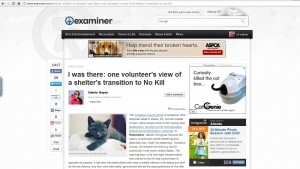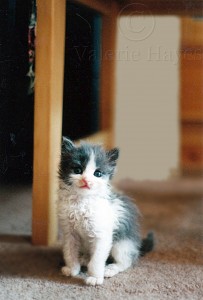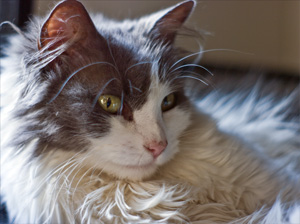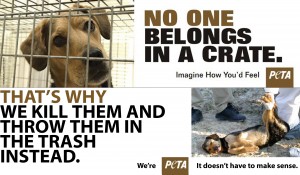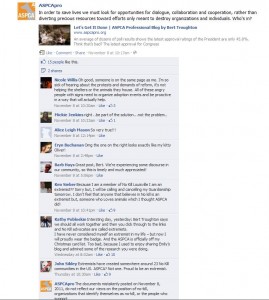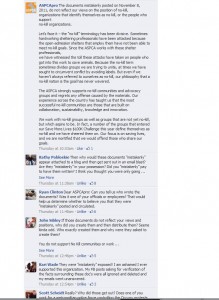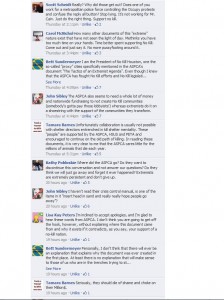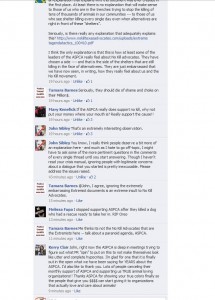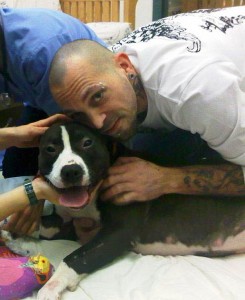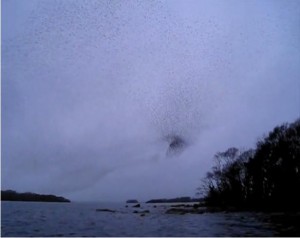An open letter to Mary Jo White, Chair of the ASPCA Board of Directors
Dear Ms. White,
I am writing to you as a longtime observer and critic of the ASPCA who would like nothing better than for the ASPCA to become an organization that I could wholeheartedly support. I love animals and all of my pets are rescues. Almost all of them are refugees of our nation’s broken animal sheltering system, rescued from, rather than by the shelters that are supposed to be their safety net. The fact that animals have to be rescued from shelters which are not places of safety but are places of abuse and killing is the irony at the heart of why I cannot support the ASPCA, an organization which claims to be on the side of animals, and was founded to be on the side of animals, but which is instead fighting to maintain the deplorable status quo in NYCACC and “shelters” across the country, and fighting against No Kill shelter reform in Austin, TX and elsewhere (thankfully FixAustin and Austin Pets Alive! won that round). Tragic irony is the way of the warped world of animal sheltering. (I almost said “way of life,” but that would have been utterly inappropriate.)
Your ad campaigns are ubiquitous. When I was sitting down to write this, I found that articles I’d written critical of the ASPCA and articles I’d written about situations which illustrate the need for shelter reform and genuine shelter access legislation had ASPCA ads on them. One had a total of four ASPCA ads, and it was specifically about the ASPCA’s opposition to shelter reform and access legislation! No wonder people are so confused and continue to send you enormous amounts of money even as you fail to clean up the mess you helped create in your own backyard and even as you promote legislation like the Quick Kill Bill (sponsored by Assemblywoman Amy Paulin) and oppose legislation like CAARA (sponsored by Assemblyman Micah Kellner), which would save animal lives and go a long way to advancing the humane treatment of animal rescuers by guaranteeing them the right to rescue even when they speak out about abuses that they witness.
Do not try to tell me that the Paulin bill is wonderful for animals or that the Kellner bill is inadequate. Nonsense! I have the unfair advantage of having actually read them both. I will not be fooled, only further irritated by any such attempts to insult my intelligence, and I’m already pretty ticked off.
I used to live near the ASPCA’s home turf of New York City, and I’ve known the ugly reality hidden behind the cute calendars for many years—since the early-mid 1980s, to be more precise, when the ASPCA ran animal control for NYC, and when I first heard the below parable of the accountant and the veterinarian, which I recounted in a previous article about the ASPCA’s opposition to Oreo’s Law. It was quite the chamber of horrors back then, worse even than NYCACC is now. (I’m always perplexed by people who, upon finding out the truth about the ASPCA, think that it has very recently strayed, like in the past few years. Not so. It’s just that more people are becoming aware of it)
The ASPCA has long been a nice comfortable killing machine. It’s really quite amazing how times have changed and not changed…
An accountant was visiting his client, a veterinarian who worked for the ASPCA in addition to his private practice. In fact, he seemed to spend a lot more hours at the ASPCA than he devoted to his private practice, even though they weren’t paying him all that much. The accountant was at the vet’s office wrestling the books into some semblance of order and a very friendly dog with a badly scarred and misshapen head came galumphing over to be petted, and the accountant obliged him. The dog was friendly to the point of making a pest of himself by attempting to be an oversized lap dog. The accountant shooed him away so that he could get some work done. He could hear the clop-clop of the dog’s paws on the floor as he went down the hall, around a corner, and back up another hall to reappear at the opposite door of the office he was working in, with a look on his scarred face that said “Hi, I’m a different dog than the one that was just here a minute ago, pet me too”.
The dog had come to reside temporarily at the vet’s office as a result of the vet’s work for the ASPCA. He’d come in as a badly injured stray. Someone had apparently beaten him and he had multiple fractures to his skull, which the vet, who is well-respected for his considerable skills as a surgeon, had spent hours in surgery wiring back together. He practically donated some very fancy surgery to them because that’s the kind of person he is. They wanted to kill the dog after all that–”a friendly dog who wouldn’t win any beauty contests”, as the accountant described him. The vet removed the dog from their custody instead. The accountant told the vet that while he admired the work he did on behalf of this dog and other animals at the ASPCA, it was his responsibility as accountant to advise him to leave the ASPCA and concentrate on his private practice, and frankly, he couldn’t understand why he took that kind of abuse from them, and for so little money. The vet’s reply was impossible to argue with:
“The animals need me.”
One protector in the killing machine was better than nothing at all. I can’t imagine how he did it for as long as he did. The tradition of killing animals for being there and abusing those who would do otherwise is a long one there. I am perpetually amazed at people who see it as a benevolent place. Apparently their marketing has done its job, but it would take a lot more than some nice packaging to remove the image of that dog my father described so vividly and what the ASPCA wanted to do to him, and to the vet.
I hadn’t thought of that dog in years, but recent events have made him restless. He’s been making his circuit down the hall, around the corner, and up the other hall, to reappear at the opposite door. Always the same question:
“Will it be different this time?”
When will it ever be different?
Years later, in 2000-2001, I had the excruciatingly painful experience of volunteering at a shelter and fostering a litter of kittens in my home for a month. They were healthy and delightful little kittens and I did what I was told, returned them to the shelter when they were old enough for adoption. The shelter reneged on its promise to call me if they were in danger of being killed for any reason and instead killed two of them when I had made it clear that I was only a phone call away. Boy, was I naive! There wasn’t even any call. Those two adorable little kittens were instead injected with poison and thrown in the trash as if their lives truly did not matter and I was treated like trash, my efforts, my ideas, my feelings, my personhood of no consequence to people for whom making a phone call was a greater inconvenience than killing two little kittens. Its not like I was anonymous to them either, I was at the shelter volunteering every week. Did they think I would take that lying down or that I wouldn’t find out? Or perhaps, more chillingly, did killing kittens with a human attachment, and to someone they saw every week, have an added measure of attraction? All of these scenarios are possible, and all of them happen in shelters. Thankfully, the volunteers at the Tompkins County SPCA rebelled against the status quo. We looked at each other and realized that we were not alone. We stood up for the animals and we stood up for ourselves. The animals deserved to live and we deserved to be treated like human beings. Less than a year after my kittens were so needlessly killed, Tompkins County made history by ending its killing of healthy and treatable pets and becoming the first No Kill community in the country. To this day, it remains the only one in New York State.
What the heck are you people doing with that $140 million that you raise every year?
I wrote about that experience and received many comments and emails that went like this:
I run a rescue group. My local shelter killed animals I specifically called and said I was on my way to pick up. Why? Because like you, I complained about the shelter publicly. I tried to work with them, but my concerns were ignored. They said I was unreasonable because I thought dogs should have access to clean water. I am so sick of people saying shelters have no choice but to kill, that they work hard, that they care so much. Tell it to the two dogs I was on my way to save when they thought they would teach me a lesson by killing them. I will never forget the look on the staff’s face when I arrived. They were smiling and smirking. As soon as I saw them, I knew something was terribly wrong. I just could not imagine that it was that. I’ve not been back since then.
Have you ever thought for a minute what it is like for someone to have an animal they had offered to rescue killed to spite them or because of rampant incompetence? Have you ever thought about what it is like to have that agony compounded by the knowledge that huge, enormously wealthy organizations not only won’t go to bat for you and the animals you’re trying to save, but that they’ll label you ‘divisive’ or an ‘extremist’ for speaking out about it, that they’ll instead back those who kill animals out of spite and incompetence, even going so far as to enshrine this sort of abuse in legislation? Spend a few minutes trying to put yourself in the shoes of animal advocates and rescuers. If you have a pet, hold them on your lap. Picture them being killed in a shelter while you were on your way to pick them up. How would that make you feel? How would you feel if you were then called names by your pet’s killers? What would you do next? Would you be able to continue rescuing, knowing that this could happen again and again?

Will the A actually do something to prevent tragedies like this from happening in NYS? I sure hope so for the sake of animals and rescuers in NYS, and in GA.
Why on earth should this be allowed? Why on earth is one of the largest and wealthiest animal organizations on earth trying to pass legislation that would ensure that it continues happening, to block legislation that would make it illegal, and to fight grassroots reform efforts?
Unlike the animals in shelters, and unlike those of us who have experienced firsthand the need for CAARA and other genuine shelter access and reform legislation, you are in a position that affords you tremendous leverage. You are Chair of the Board of one of the largest and wealthiest animal organizations in the world. You could literally turn the world around for the 3-4 million animals who die annually in America’s shelters because what you decide to do right here, right now in New York State will set a precedent for every shelter and every legislature in the country. You could save so many animal rescuers from the torment they face every day without laws protecting their right to rescue. You could make a huge positive difference in the lives of shelter employees. You could spare untold numbers of pet owners the agony of having their pet killed in a shelter before they could get there to pick them up.
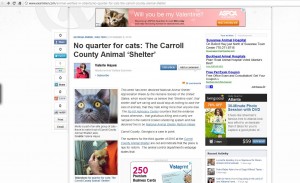
Will the A act to end rampant killing in NYS? It would make it easier to do the same in GA and we need all the help we can get. Dead kitties don't make such good valentines.
You have the power to hold your CEO, Ed Sayres accountable for actually protecting animals and animal rescuers for the first time in his life. You can order him to withdraw ASPCA support for A5449, the Quick Kill Bill and to join the No Kill Advocacy Center, Alley Cat Allies, Best Friends Animal Society, No Kill Nation, and thousands of private citizens in support of CAARA instead.
You have the power to fire him.
You have the power to hire someone who would make Henry Bergh proud.
You have the power to make it different this time. You have the responsibility to make it different this time.
I, and many others will rejoice if you do. We’ll keep fighting if you fail to.
Sincerely,
Valerie Hayes
P.S. I said that almost all of my pets were refugees from the broken animal sheltering system. Ernest had the good fortune to arrive at the Tompkins County SPCA in August 2001. She was only 10 days old. (What can I say? kittens are hard to sex at that age!) She arrived at a shelter that was truly a shelter for her, a place where she and her mother and litter mates were guaranteed continued life and the foster care placement that they needed. Had she arrived at the shelter just two months earlier, prior to June 11, 2001, her story would very likely have ended in much the same way as those two little kittens I’d fostered only to have the shelter turn around and kill them–luckless, betrayed and dead in a trash bag.
I thought I’d built up an immunity to cuteness, but the charms of the little runt kitten with the Don King hairdo proved too much for me, and I ended up adopting her. We were both very lucky. She had a shelter that was truly a shelter when she needed it most. So many are not so fortunate. They are the voiceless, the ghosts that haunt the animal welfare movement, the unseen, unsaved millions.

